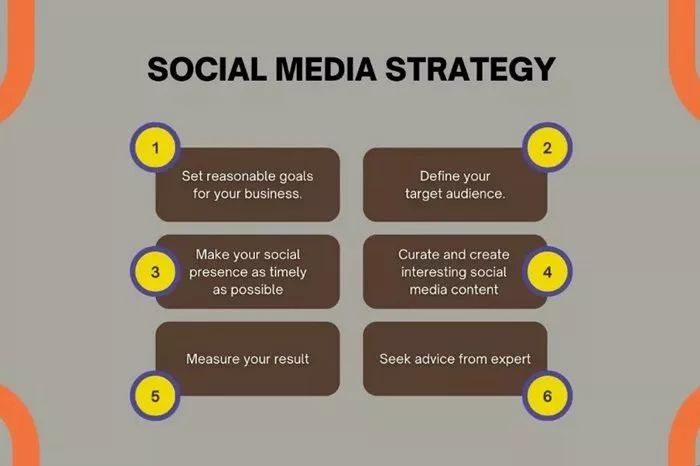Social media marketing has transformed the way businesses interact with their audience, build brands, and achieve marketing goals. For any organization, crafting a robust social media marketing plan is crucial. What is the first step of a social media marketing plan? Among its six essential steps, the first one serves as the foundation for all subsequent actions. Let’s delve into this critical starting point: defining your objectives and understanding your target audience.
Defining Your Objectives
The first step in a social media marketing plan involves setting clear and actionable objectives. Without knowing your goals, you risk wasting time, resources, and effort. Here’s a detailed breakdown of how to approach this step:
Understand Why You’re Using Social Media
Businesses utilize social media for various reasons, including brand awareness, lead generation, customer engagement, or direct sales. Identifying your purpose will help you decide which platforms, content types, and strategies align with your goals.
For instance, if your primary aim is to build brand awareness, platforms like Instagram or TikTok might be more suitable due to their focus on visuals and wide reach. Conversely, LinkedIn could be ideal for B2B businesses aiming for professional connections.
Set SMART Goals
When defining your objectives, ensure they are SMART: Specific, Measurable, Achievable, Relevant, and Time-bound. For example:
- Specific: Increase Instagram followers.
- Measurable: Gain 1,000 followers.
- Achievable: Allocate time and resources to create daily content.
- Relevant: Focus on Instagram because the target demographic is present there.
- Time-bound: Achieve this within three months.
SMART goals provide clarity and help measure success.
Align Objectives With Business Goals
Social media marketing objectives should complement your overall business goals. If your company’s primary objective is to increase e-commerce sales by 20%, your social media goal might involve driving website traffic through promotional posts and ads.
Identifying Your Target Audience
After setting objectives, understanding your target audience is a crucial part of this initial step. A well-defined audience allows for personalized content, increased engagement, and effective use of resources.
Create Buyer Personas
Buyer personas are fictional representations of your ideal customers. They are based on data and help identify demographics, behaviors, preferences, and pain points. Key elements of a buyer persona include:
- Demographics: Age, gender, location, and income level.
- Interests: Hobbies, media consumption habits, and online activities.
- Challenges: Problems your product or service can solve.
For example, a persona for a fitness brand might be:
- Name: Fitness Fiona
- Age: 28
- Interest: Yoga and wellness podcasts
- Pain Point: Lack of affordable gym options nearby
Creating such personas ensures your strategy resonates with the right people.
Analyze Existing Customers
Your current customer base provides valuable insights. Use data from CRM systems, website analytics, and past social media campaigns to identify patterns. For example, if most of your website traffic comes from Pinterest, it’s a sign your target audience may be highly active on that platform.
Study Competitors
Competitor analysis helps identify gaps and opportunities. Observe their followers, engagement rates, and popular content types. This doesn’t mean copying their strategy but understanding what works and tailoring it to your unique offering.
Choosing the Right Metrics
Setting objectives and understanding your audience also means knowing which metrics to track. Common social media metrics include:
- Reach and Impressions: Measure brand awareness.
- Engagement Rate: Reflects audience interaction through likes, comments, and shares.
- Click-Through Rate (CTR): Indicates interest in the content that leads to your website.
- Conversion Rate: Tracks how many users complete a desired action, like signing up or purchasing.
Selecting the right metrics depends on your goals. For instance, a campaign focused on awareness might prioritize reach over conversions.
Platform Selection Based on Objectives
Not all platforms are created equal. Each serves different purposes and attracts varying audiences. The choice should be based on the goals and audience defined in this first step.
- Facebook: Broad audience, great for building community groups.
- Instagram: Visual storytelling, ideal for product showcases.
- LinkedIn: B2B connections and professional engagement.
- Twitter: Quick updates and news sharing.
- TikTok: Creative, short-form video content targeting younger demographics.
The Role of Competitive Benchmarking
Competitive benchmarking is a valuable component of the first step. By evaluating industry standards and competitors’ performance, businesses can set realistic and aspirational goals. Here’s how to benchmark effectively:
- Identify Key Competitors: List brands that target similar audiences.
- Track Their Metrics: Observe their follower count, engagement rates, and content frequency.
- Analyze Content: Note which types of posts perform well and why.
- Set Benchmarks: Use this data to set performance standards for your campaigns.
Conducting Social Media Audits
A social media audit involves reviewing your existing profiles and strategies. It provides a clear picture of what’s working and what’s not. Key elements of an audit include:
- Profile Analysis: Ensure consistency in branding across all platforms.
- Content Review: Identify top-performing posts and patterns.
- Audience Feedback: Examine comments, reviews, and messages for insights.
An audit lays the groundwork for effective goal-setting and audience targeting.
Conclusion
The first step of a six-step social media marketing plan—defining objectives and understanding your audience—is the cornerstone of any successful strategy. By setting clear, SMART goals and creating detailed buyer personas, businesses ensure their efforts are targeted and impactful. This initial step not only establishes the direction for the remaining five steps but also optimizes resources, drives engagement, and achieves measurable results. Building a strong foundation ensures that your social media campaigns resonate with the right audience and deliver meaningful outcomes.
Related Topics
- Why Social Media Marketing Efforts Fail?
- How Effective Is Social Media Marketing?
- What Is Social Media Marketing Used For?

